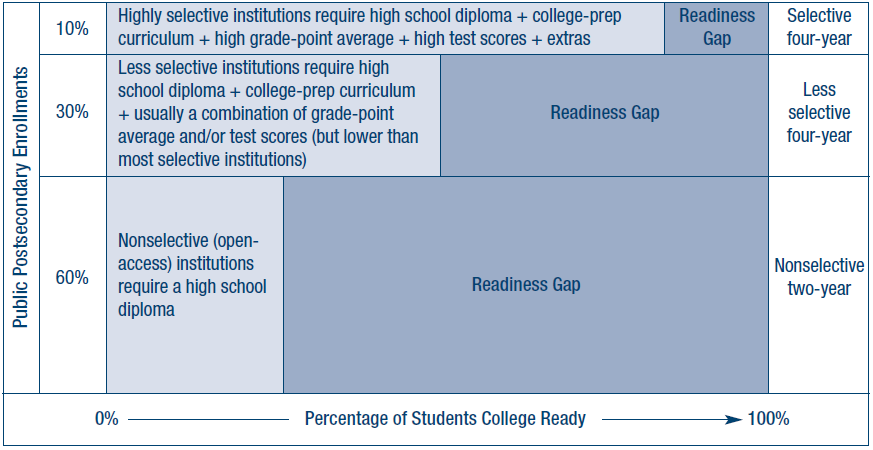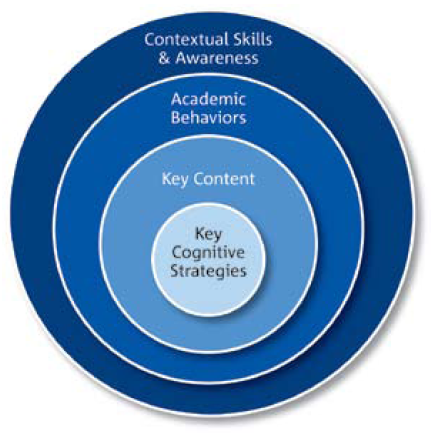Get ‘em Ready…
Over the past 20+ years I have been fortunate to have been able to work across both the K-12 and Higher Education sectors as an educator, administrator, and service provider. The one thing that is common among public schools, charter schools, for profit schools (HE & K-12), private colleges and public colleges is that they all share one objective – to provide students with learning opportunities that will help them grow and achieve their potential. While they all have different methods and philosophy’s on how to achieve this, they all share a common vision.
With that, there is one major disconnect between K-12 and Higher Education. It is something everyone recognizes as a major problem but many do not understand the causation. It is College Readiness.
- If you ask a primary teacher what their objective is for their students, they will tell you ‘to get them ready for middle school’.
- If you ask a middle school teacher what their objective is for their students, they will tell you ‘to get them ready for high school’.
- If you ask a high school teacher what their objective is for their students, they will tell you ‘to get them ready for college’.
- If you ask a college instructor what their objective is for their students, they will tell you ‘to get them ready for the world of work’.
What is frightening about this is that there is often little communication between each of the individual groups of educators in order to understand what they are ‘getting their students ready for’. Exit outcomes are defined on perception of what the entry requirements are for the next level but in many cases, they do not align.
According to the Southern Regional Educational Board, a collaborative of 16 Southern states, 60% of students graduate from high school believing they are ready for college but upon entry, learn they are not prepared and require remediation – courses they need to pay for but do not receive credit for (no, that is not a typo – 60%).
Readiness Gap by Institutional Sector
 Source: Beyond the Rhetoric Improving College Readiness Through Coherent State Policy, SREB, June 2010
Source: Beyond the Rhetoric Improving College Readiness Through Coherent State Policy, SREB, June 2010
It is no surprise that the ‘highly selective’ institutions receive the most highly qualified students and do not need to deal with the college readiness issue. The challenge lies in the more open programs as they are tasked with bridging the gap for the majority of their students.
Before reading on, it is very important to note that it is not that K-12 are not doing a good job in preparing students. The fact is, the exit requirements for high school do not match the entry requirements for college.
If I were a preacher, I would say that again – the fact is, the exit requirements for high school do not match the entry requirements of college. Case in point, the typical grade 12 English curriculum focuses on literature while the standard entry-level English course for college focuses on reading and composition (and there are many other examples). Get the point? It is like the cartoon of two sets of engineers who start building a bridge at different sides of the cavern and it does not come together in the middle.
Enter the Common Core. One of the driving forces behind the Common Core is to align the exit outcomes of high school with the entry level requirements of college and to eliminate the readiness gap. This is going to help a great deal (although it is going to take some time) but there is still a number major challenges that the Common Core is not addressing – two of which are Contextual Skills & Awareness and Academic Behaviors.
Facets of College Readiness
 Source: Redefining College Readiness, David T. Conley, March 2007
Source: Redefining College Readiness, David T. Conley, March 2007
| Academic Behaviors: Self Awareness, Self-motivation, self-control
Contextual Skills & Awareness: Understanding ‘how’ college operates – ranging from culture, student aid, systemic understanding, time management, preparation, ability to organize, etc. |
While the Common Core will address key cognitive strategies and key content, it is unclear how academic behaviors and contextual skills and awareness will be covered – if at all.
I recall being shocked when I entered my first college course – Economics 101. It was in a ‘teaching theater’ (isn’t that paradoxical?) with over 150 students. Now, keep in mind I had just graduated from a high school with class sizes in the twenty’s and instruction provided through collaborative, cooperative, engaging environments. I had no idea how to cope (will save that for a future blog on ‘self-paced learning’). Nearly every student entering college faces similar situations.
To expound on this, a similar situation exists between the exit of college and the entrance into the workplace. Numerous surveys have illustrated that employers want students who have more than the requisite knowledge to do the job, they need students to come prepared to work in collaborative environments, provide leadership and solve problems – not skills that are typically focused on in college.
There are, of course exceptions to this. A number of Community Colleges are developing and implementing innovative programs in tandem with manufacturers and other business through which these skills are imbued into the programs – and ensure students are workforce ready upon exit. It is programs like these that will flourish in our new generation of learning.
Bottom line though, insuring a smooth transition between high school and college and college and the workforce is not going to be easy and not going to be solved by a single set of standards. It is going to require ongoing, mindful, structured dialogues among all stakeholders. Conversations need to be open, collaborative, and enduring. This is the only way we will be able to better prepare learners for all of the transitions they face from kindergarten to their entry into the workforce and beyond… preparing all to be lifelong learners.